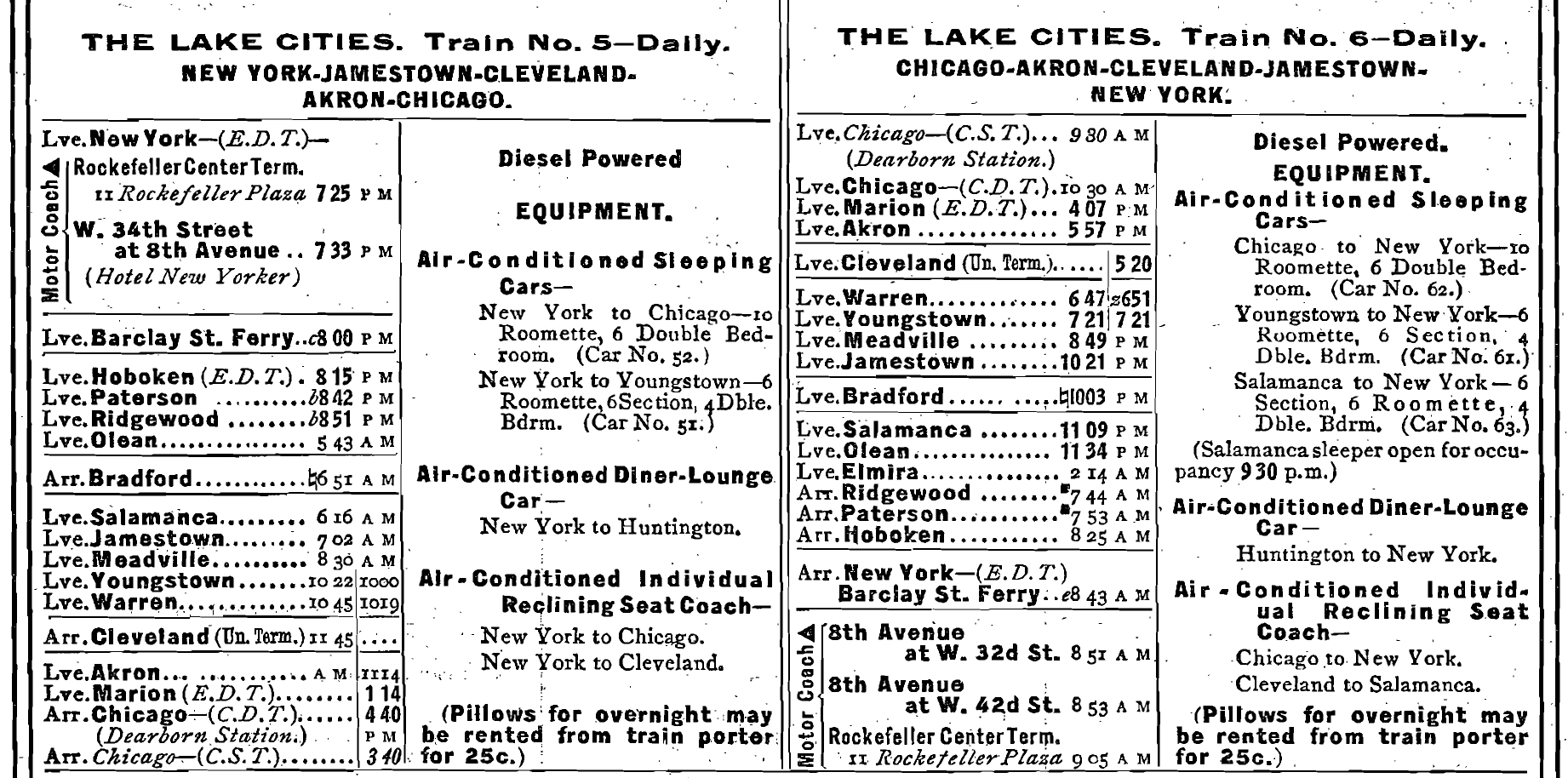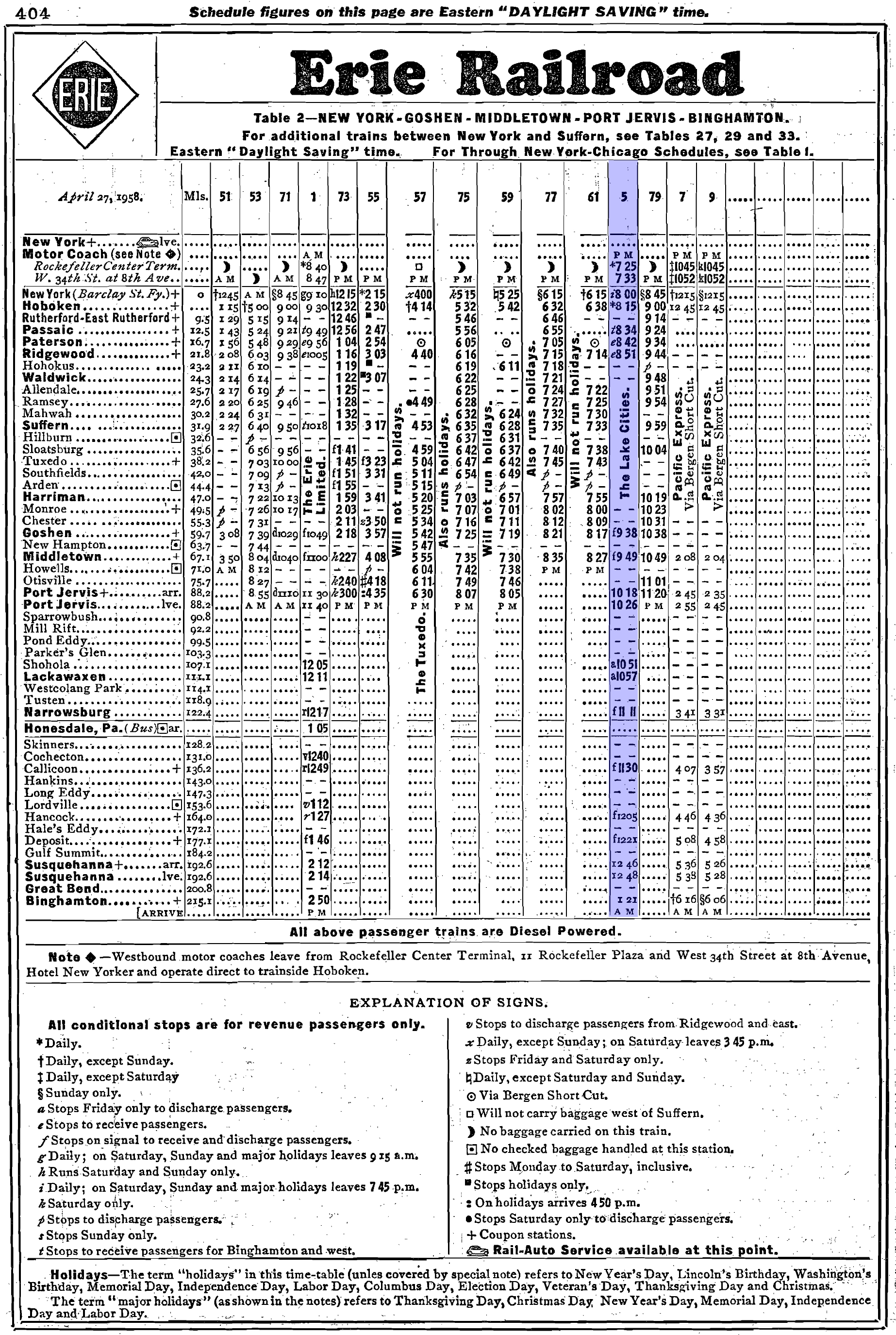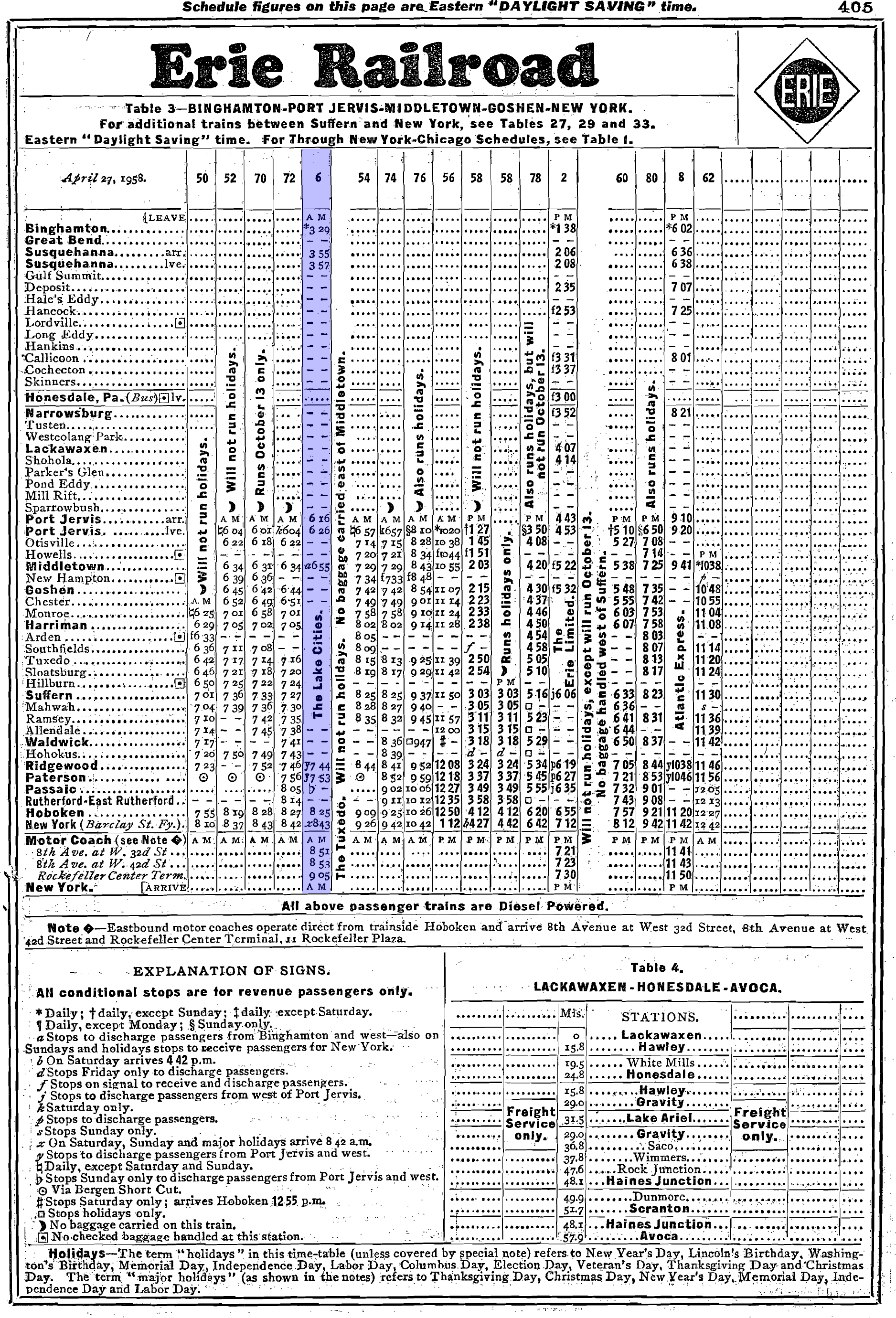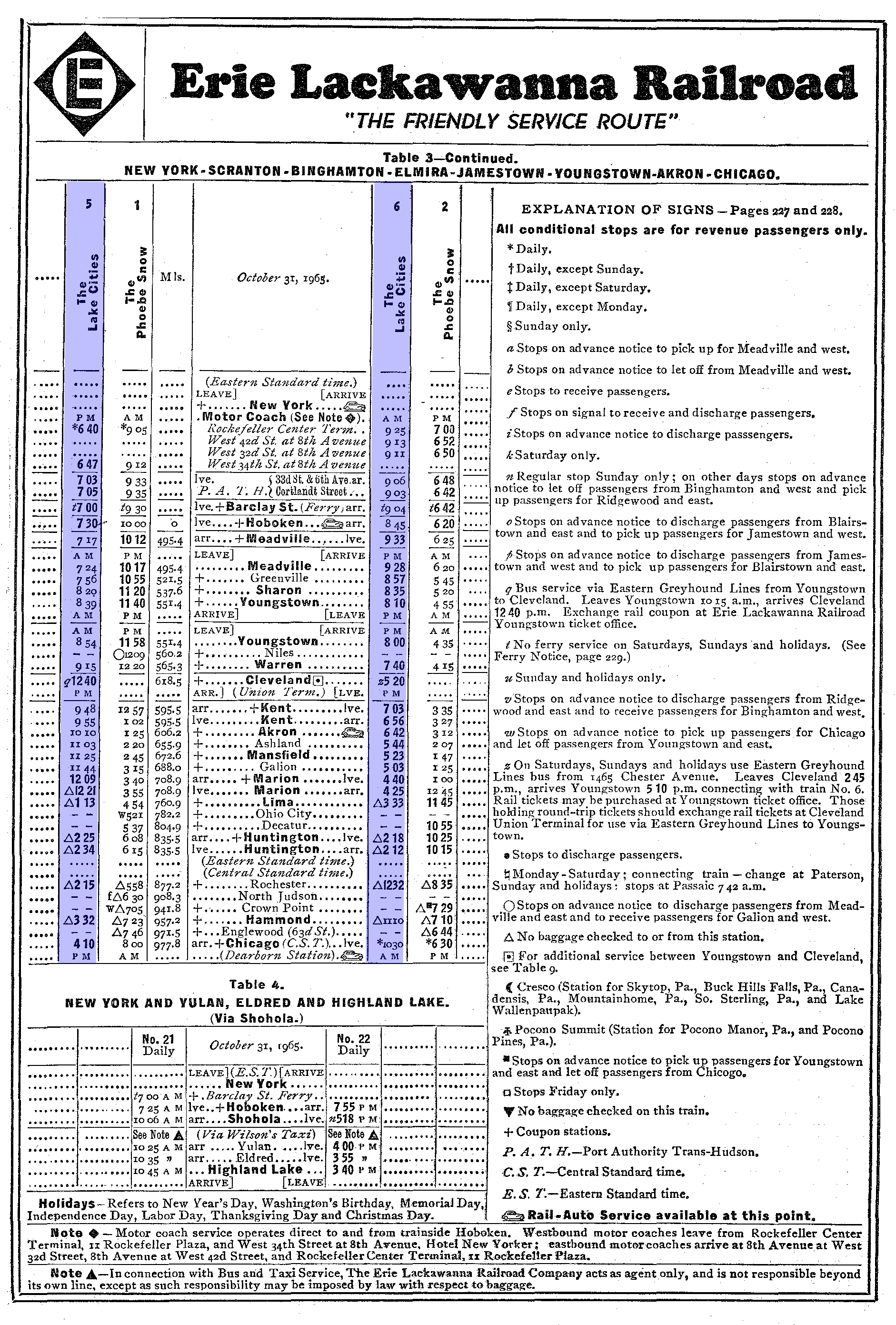The "Lake Cities": Jersey City - Chicago
Last revised: September 2, 2024
By: Adam Burns
The Lake Cities was a passenger train operated by the Erie Railroad, and later Erie Lackawanna between Chicagoand Hoboken, New Jersey.
It was launched in 1946 as a daytime accompaniment to the Erie Limited and was one of the Erie's flagship services.
The train had an on-again, off-again operation but managed to survive nearly until the start of Amtrak. As the "fourth way to Chicago," the Erie/EL, and its passenger trains, are often forgotten. Nevertheless, the railroad provided first-class service for which it is still remembered today.
The Lake Cities was named after the numerous cities along the Erie's main line that were named after or located near the Great Lakes. The train was finally discontinued by the Erie Lackawanna in early January, 1970.
Photos
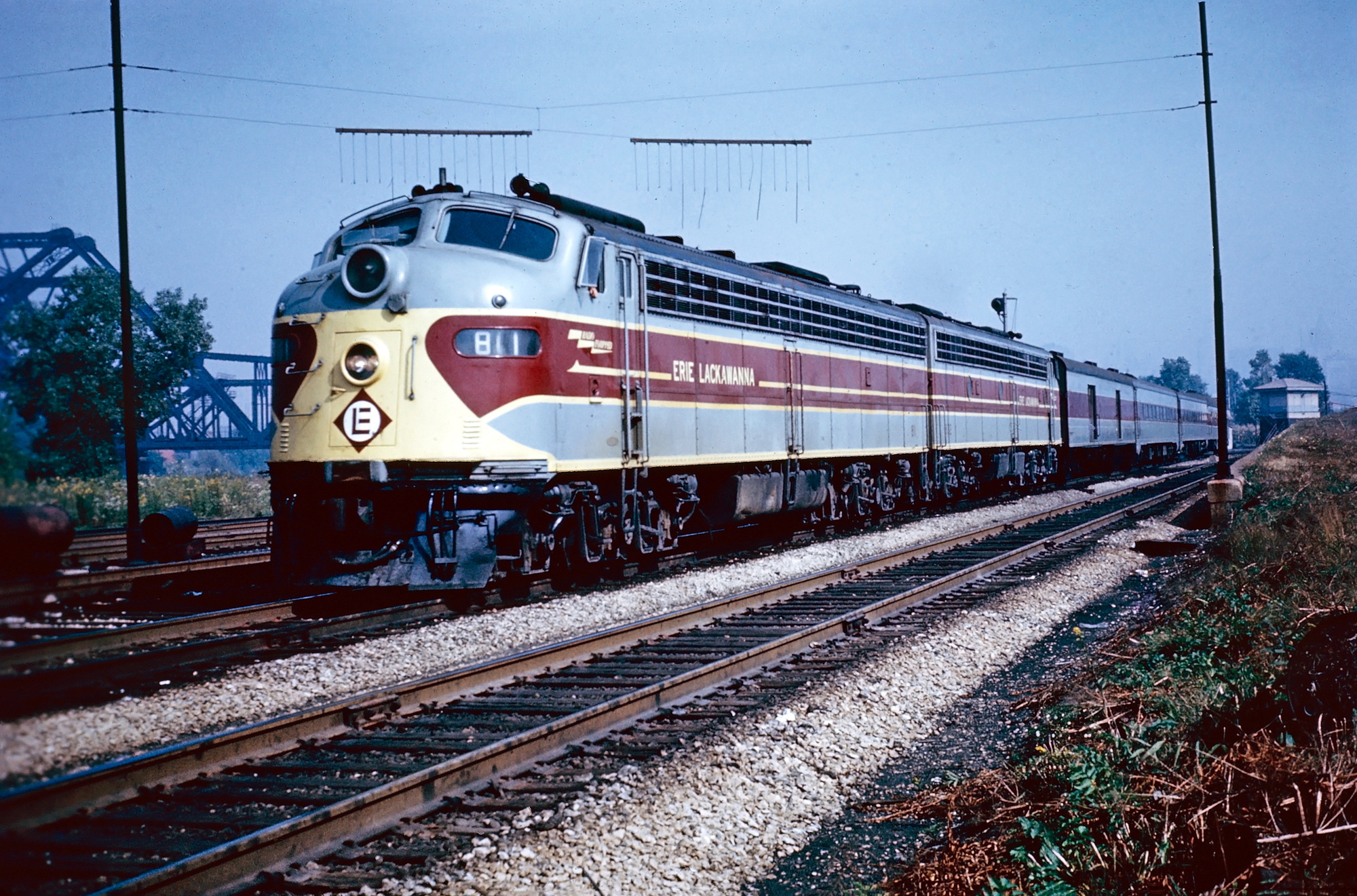 Erie Lackawanna E8A #811 departs Chicago with the "Lake Cities" in September, 1967. Photographer unknown. American-Rails.com collection.
Erie Lackawanna E8A #811 departs Chicago with the "Lake Cities" in September, 1967. Photographer unknown. American-Rails.com collection.Inauguration
The Lake Cities was one of Erie's well-known long-distance services which ran the railroad's length between Jersey City (Pavonia Terminal) and Chicago (Dearborn Station). It began as the Midlander, inaugurated on June 3, 1939 as numbers 15 and 16.
This service also included sections to Cleveland and Buffalo that operated as the Lake Cities. After less than a decade the train was renamed entirely as the Lake Cities between Jersey City-Chicago in November, 1947.
On October 17, 1960 the Erie and Delaware, Lackawanna & Western formally merged creating the Erie-Lackawanna Railroad. Afterwards the train - renumbered as 5 and 6 - began utilizing the former DL&W between Binghamton, New York and Hoboken, New Jersey, terminating at Hoboken Terminal.
The Lake Cities served as a critical connection with major stops including Cleveland, Akron and Youngstown in Ohio, and Elmira and Binghamton in New York. Encompassing the needs of the industrial heartland, the train's route from New Jersey to Illinois became a lifeline for countless industrial cities and towns.
A beacon of luxury and elegance, the Lake Cities offered superior onboard services. From sumptuously designed sleeping accommodations to high-end dining amenities filled with exquisite meals, being a passenger of the Lake Cities was a grandiose experience.
Stretching over a total distance of approximately 977.8 miles, the Lake Cities navigated through fascinating landscapes from New Jersey to Chicago. The journey required around 20 hours and 30 minutes to complete and was a testament to the train's steadfast reliability.
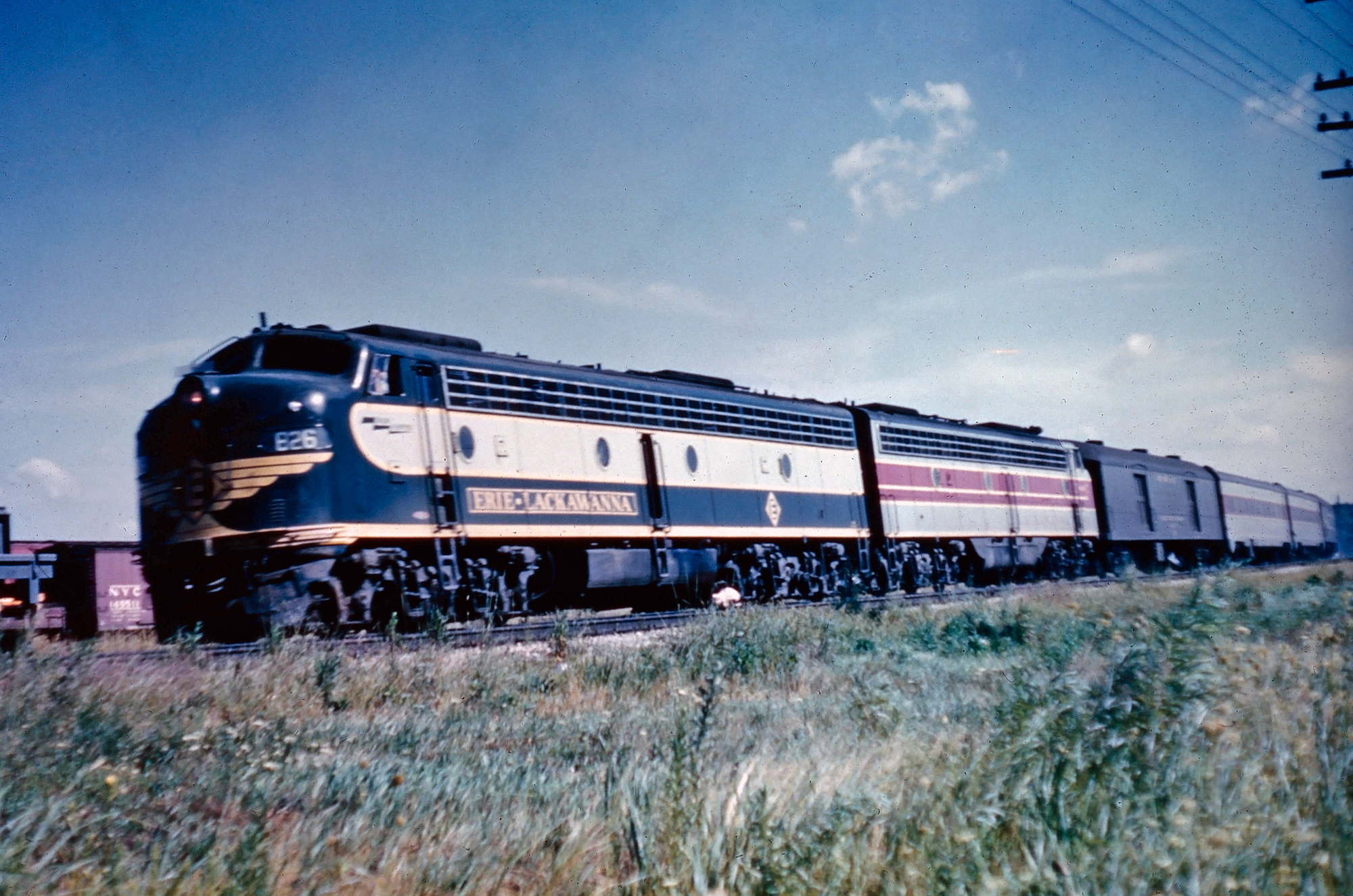 A pair of Erie-Lackawanna E8As, led by #826, have what is most likely the "Chicago Lake Cities" at Hammond, Indiana in August, 1961. Photographer unknown. American-Rails.com collection.
A pair of Erie-Lackawanna E8As, led by #826, have what is most likely the "Chicago Lake Cities" at Hammond, Indiana in August, 1961. Photographer unknown. American-Rails.com collection.Public Preception
While the public may have viewed the Erie/EL as the last option in reaching Chicago, it nevertheless provided exquisite service. In his book, "Erie Lackawanna: Death Of An American Railroad, 1938-1992," author H. Roger Grant highlights one passenger's letter to Erie management after riding the Lake Cities:
"The equipment was in fine condition; the food and service excellent; the train was handled smoothly; and no one could have asked for a more pleasant and friendly set of train crews."
During the train's operation under the EL it went through a few name changes and transformations; between May, 1961 and April 29, 1962 the train was known as the Chicago Lake Cities with the Buffalo section known as the Buffalo Lake Cities.
In addition, between April 26 and October 25, 1964 the train was known as the World's Fair in recognition of the 1964 World's Fair in New York. The EL had attempted to gain additional ridership with visitors using the train to reach the event. Unfortunately, it did little in this regard.
However, in the face of intensifying competition from the booming automobile and airline industries, passenger train services underwent a gradual decline. Consequently, by the late 1960s the EL sought the train's discontinuance.
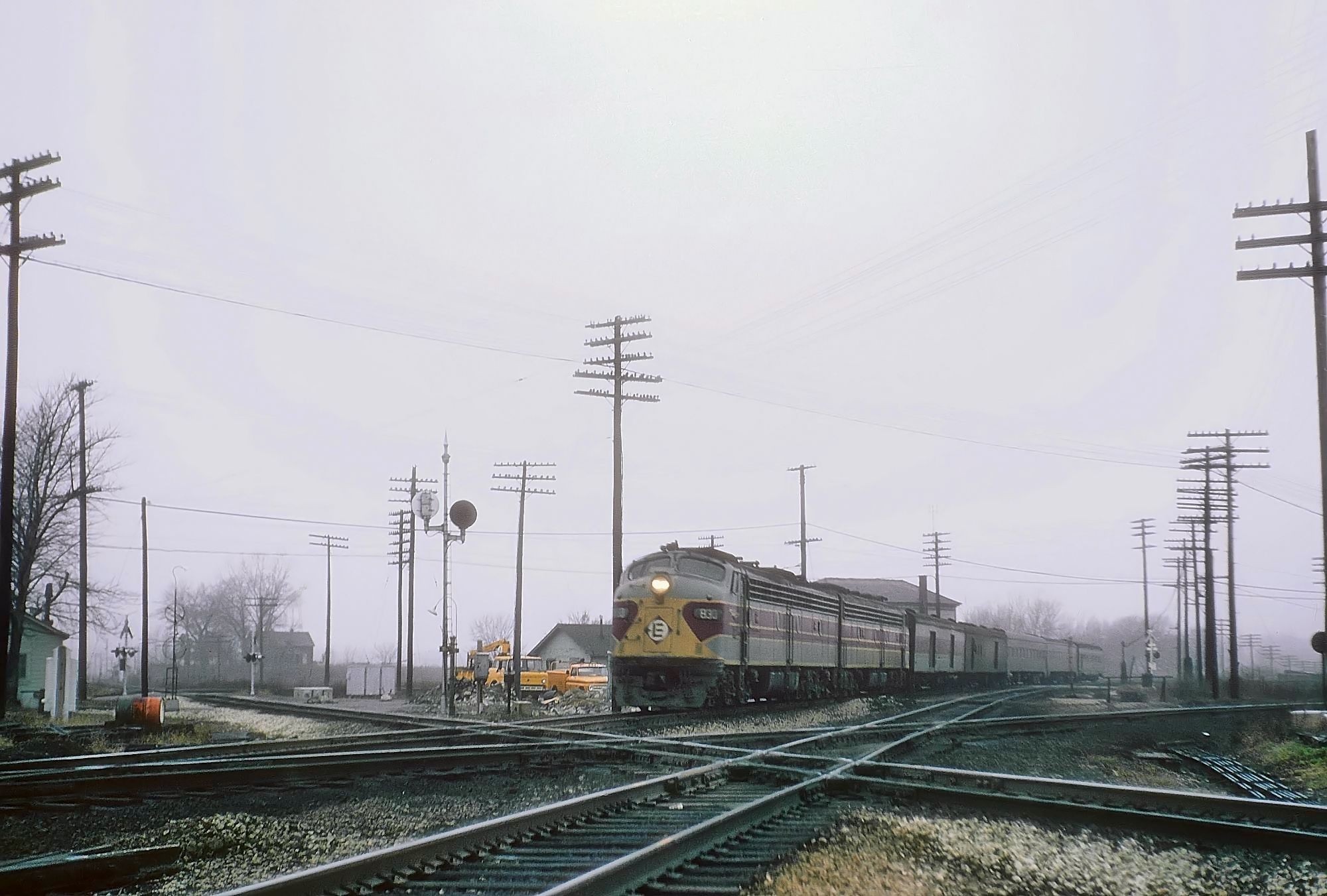 Erie Lackawanna E8A #830 has train #6, the "Lake Cities," at the once busy interlocking in North Judson, Indiana in November, 1966. Just a few traces of railroading remain here today. Rick Burn photo.
Erie Lackawanna E8A #830 has train #6, the "Lake Cities," at the once busy interlocking in North Judson, Indiana in November, 1966. Just a few traces of railroading remain here today. Rick Burn photo.As railroad attorney Wallace Steffen noted "The public liked the trains, but they didn’t use them, and this cost us a bundle after we lost the mail business."
The Interstate Commerce Commission noted the EL had done nothing to drive away business and was losing losing $2,700/day operating the Lake Cities. While the ICC urged the railroad to attempt everything in its power to continue operation it nevertheless allowed the discontinuance in 1969.
The railroad could have canceled the train as early as December 30, 1969, but agreed to continue operating it through January 5, 1970 to accommodate holiday travel.
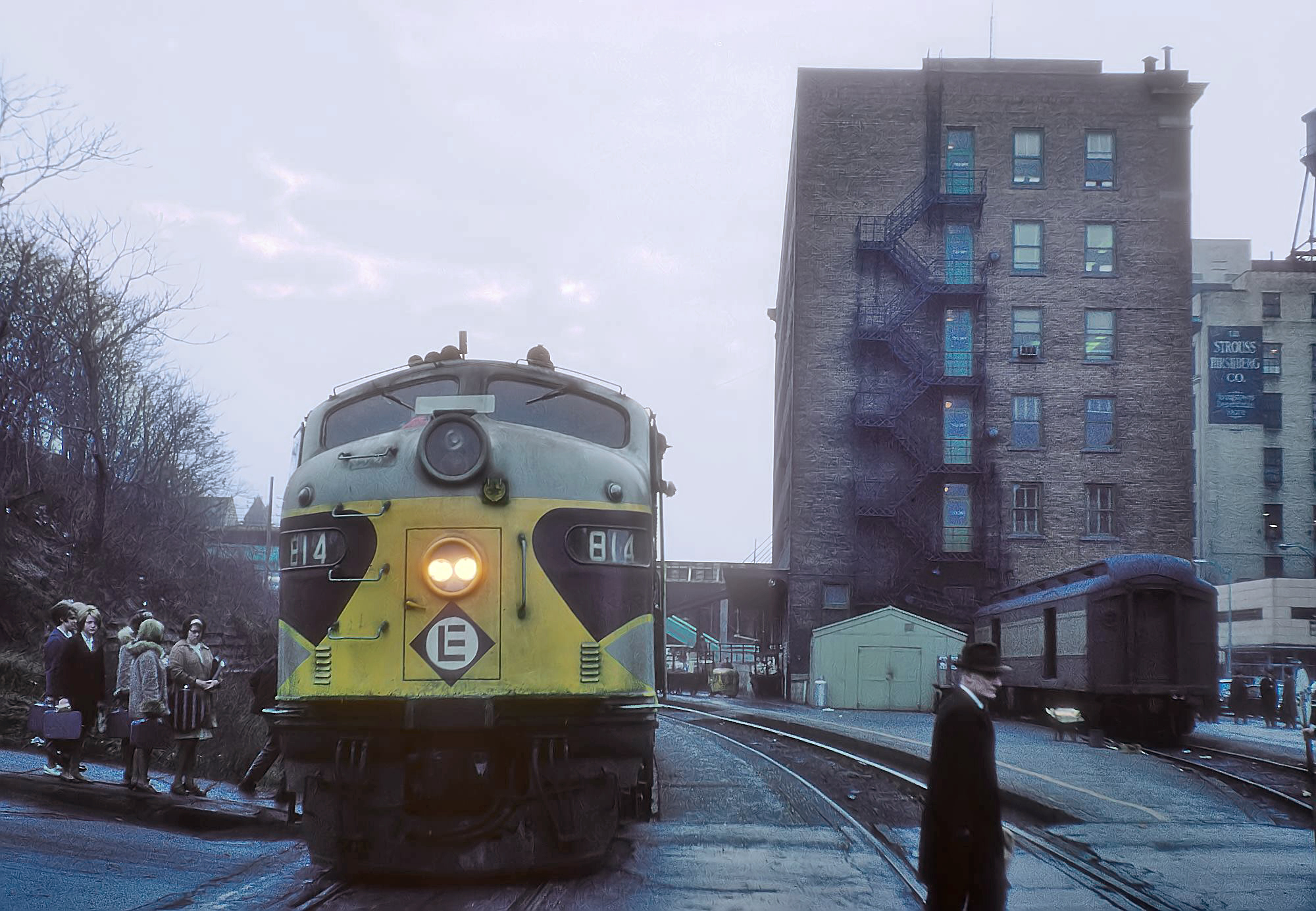 Erie Lackawanna E8A #814 has Train #5, the "Lake Cities," stopped at Youngstown, Ohio in February, 1967. Rick Burn photo.
Erie Lackawanna E8A #814 has Train #5, the "Lake Cities," stopped at Youngstown, Ohio in February, 1967. Rick Burn photo.Accommodations
Despite the cancellation, the Lake Cities' legacy continues to live on, cherished by train enthusiasts and historians alike. Throughout its operational years, it provided guests with high-quality services, unforgettable experiences, and a unique perspective on American landscapes that only a train journey could offer.
Consists
April, 1958
November, 1965 (EL)
Legacy
Though the Lake Cities is no longer in operation, its memory continues to shape the railway landscape. Its legacy is a reminder of a time when taking a train was more than just commuting; it was an unforgettable journey filled with opulence and grandeur.
The Lake Cities was one of the Erie Railroad's long-distance trains, but it also served as an essential component of the Erie Lackawanna operation after the merger. As such, it played an integral role, shaping the future of both companies and leaving an indelible mark on the industry.
The Lake Cities was a favorite of many passengers, owing to its unrivaled charm and outstanding service. It was an embodiment of the culture and quality synonymous with both the Erie Railroad and Erie Lackawanna.
Through its relatively short but impactful operational years, the Lake Cities came to epitomize the golden age of the railroad industry in America. The train was more than a means of transportation; it was a celebration of human ingenuity, the expression of progress, and the heart of industrial America.
Despite fierce competition and shifting market dynamics, the train's imprint on the annals of American railroad history is unmistakable. Like a beacon, it shone brightly, offering a level of comfort and service comparable to few.
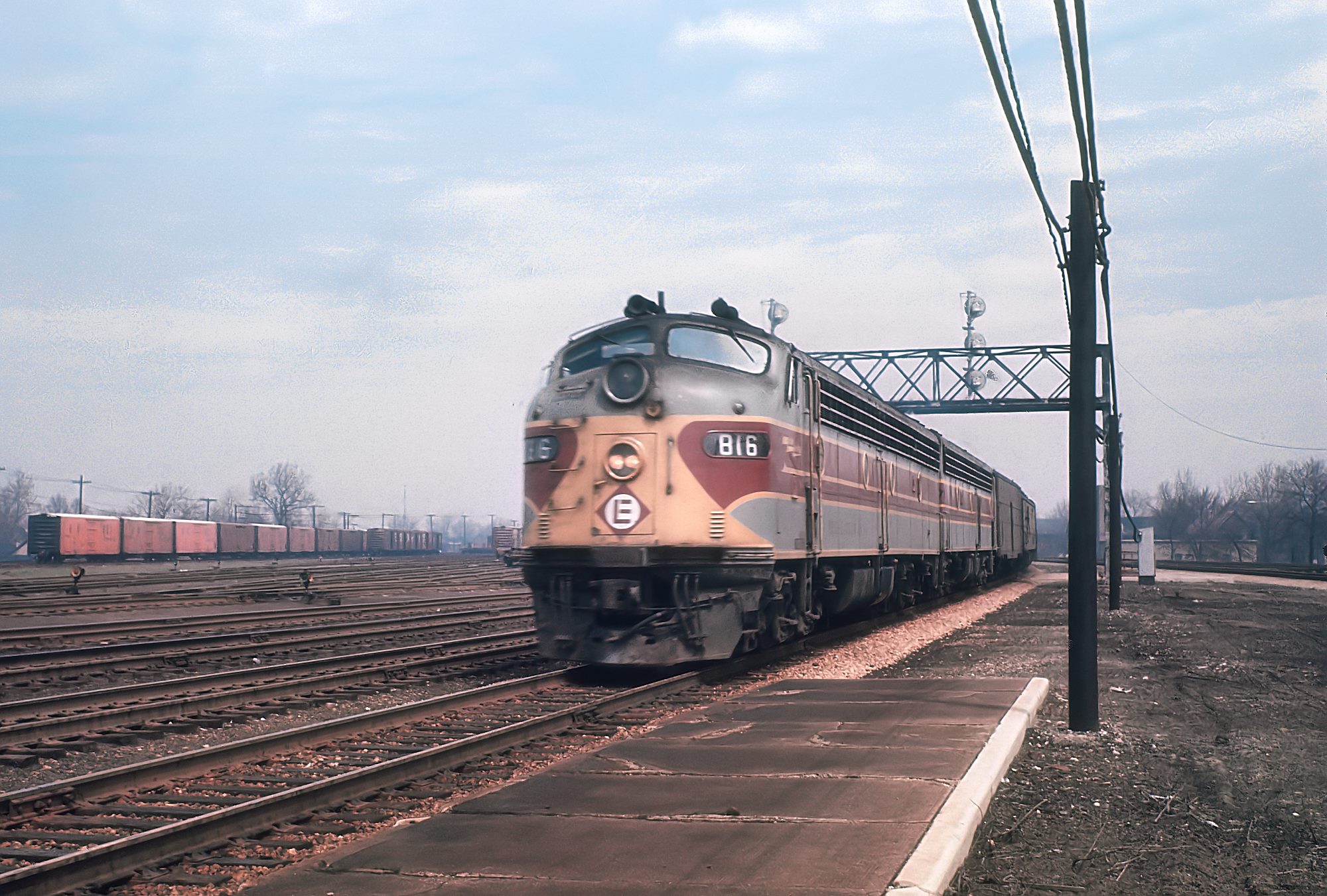 Erie Lackawanna E8A #816 has Train #5, the "Lake Cities," at 47th Street in Chicago during April, 1965. Note the Wabash/N&W yard at left. Rick Burn photo.
Erie Lackawanna E8A #816 has Train #5, the "Lake Cities," at 47th Street in Chicago during April, 1965. Note the Wabash/N&W yard at left. Rick Burn photo.Those who remember traveling on the Lake Cities speak fondly of its homely atmosphere, its impeccable service, its quality food. They reminisce about how the sprawling landscapes from New Jersey to Chicago unfolded before their eyes as the train gallantly progressed on its course.
An icon of its era, the Lake Cities' appeal was multifaceted, composed of an excellent route, consistent speed, quality on-board services, and friendly staff. Undeniably, it was a total package, a brilliant exemplification of what a long-distance train could be.
The train was a perfect example of a streamlined train—fast, efficient, comfortable, and suave. Be it the charming dining cars serving delicious meals, the cozy berths for restful sleep or the punctual departures and arrivals, the Lake Cities left no stone unturned in ensuring a memorable journey for its passengers.
The service became a symbol of the Erie Lackawanna's dedication to passenger service. It demonstrated the company's commitment to creating an enjoyable, relaxing, and fast transportation option for those traveling between the Great Lakes and New York City.
Despite its withdrawal from service over half a century ago, the Lake Cities continues to resonate in railroad history due to its central role in the operations of both Erie Railroad and its survivor, the Erie Lackawanna. Its elegance, speed, and overall commitment to passenger comfort and service will always be remembered fondly.
Timetables
April, 1958
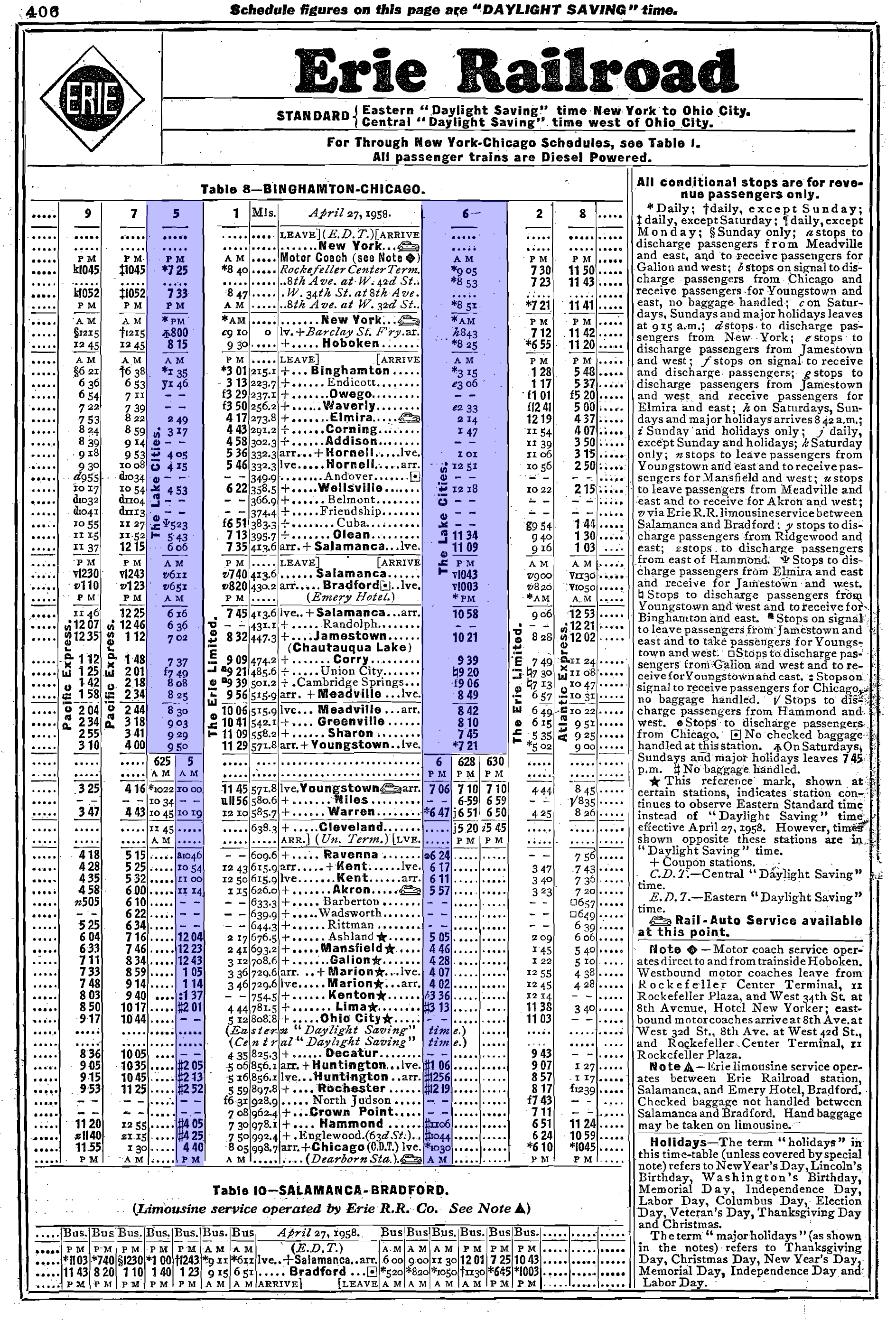
November, 1965
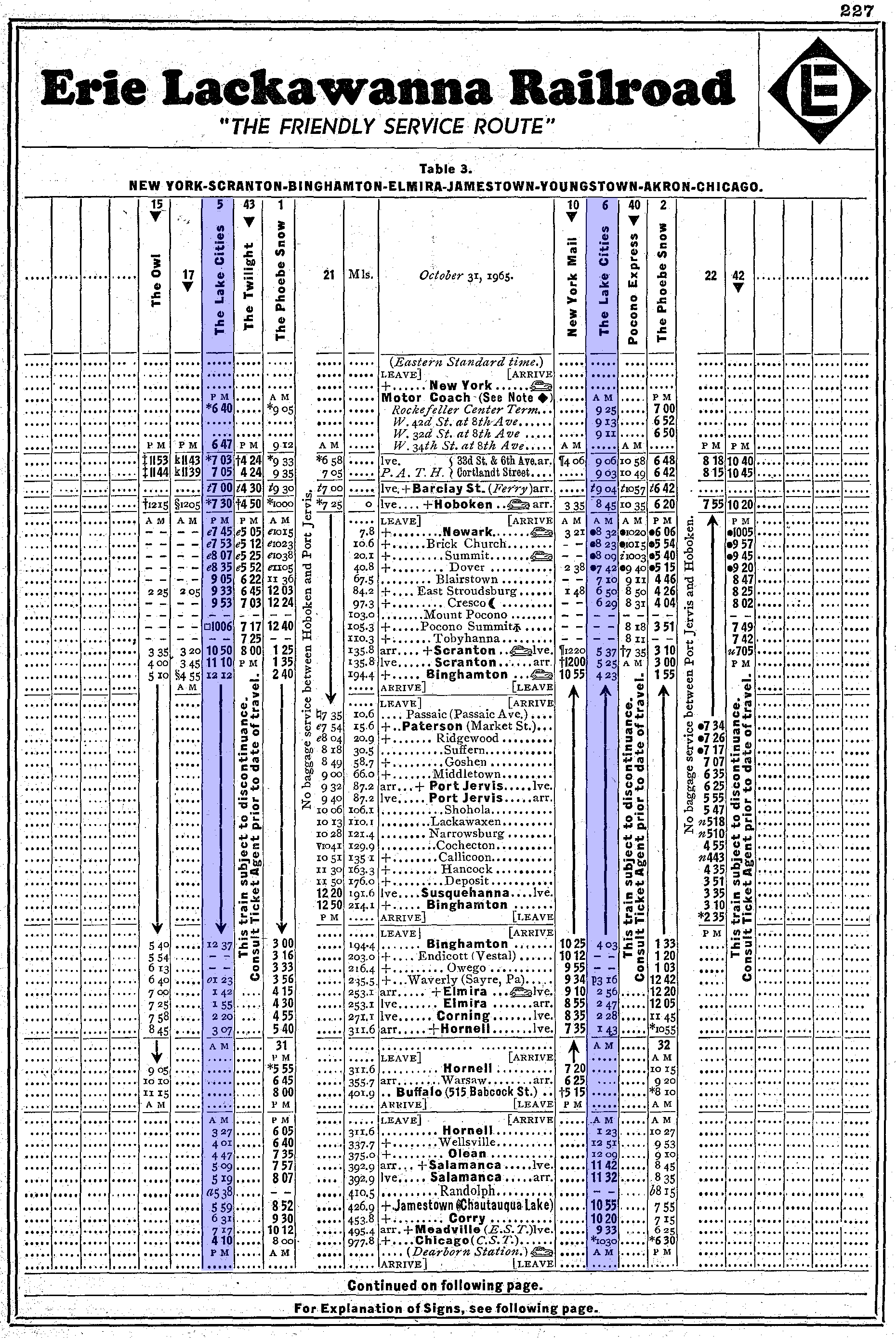
In sum, the Lake Cities embodies a unique chapter of railroad history, offering an insightful glimpse into the dynamics, operations, and service standards of mid-twentieth-century American railroading.
While it is now consigned to history, the Lake Cities continues to inspire and fascinate. Its story, immortalized in the annals of the Erie Railroad and Erie Lackawanna, serves as a beacon for future generations, reminding them of the glory days of long-distance passenger trains.
Sources
- Grant, Roger H. Erie Lackawanna: Death Of An American Railroad, 1938-1992. Stanford: Stanford University Press, 1994.
- Schafer, Mike. More Classic American Railroads. Osceola: MBI Publishing, 2000.
Recent Articles
-
Indiana - Whiskey - Train Rides
Dec 23, 25 06:40 PM
Whether you're a local resident or a traveler looking to explore Indiana from a unique perspective, hopping on a whiskey train ride is a journey worth considering. -
California - Wine Tasting - Train Rides
Dec 23, 25 06:33 PM
This article explores the charm, routes, and offerings of these unique wine tasting trains that traverse California’s picturesque landscapes. -
Alabama - Wine Tasting - Train Rides
Dec 23, 25 06:26 PM
While the state might not be the first to come to mind when one thinks of wine or train travel, the unique concept of wine tasting trains adds a refreshing twist to the Alabama tourism scene.

